Input interpretation

acetaldehyde
Chemical names and formulas
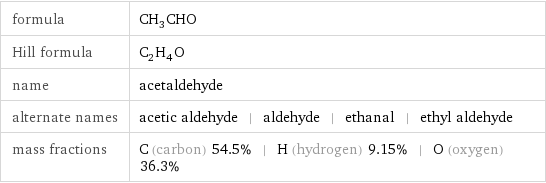
formula | CH_3CHO Hill formula | C_2H_4O name | acetaldehyde alternate names | acetic aldehyde | aldehyde | ethanal | ethyl aldehyde mass fractions | C (carbon) 54.5% | H (hydrogen) 9.15% | O (oxygen) 36.3%
Lewis structure
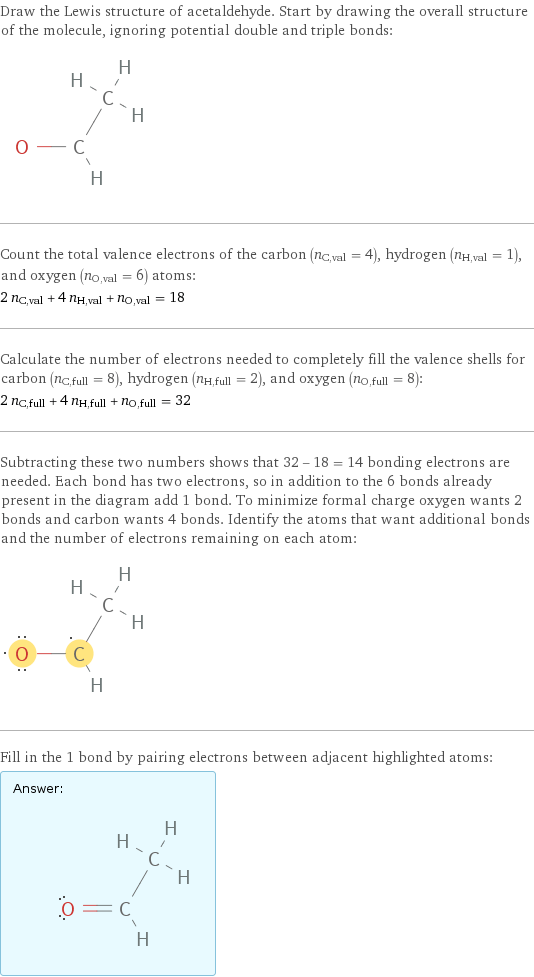
Draw the Lewis structure of acetaldehyde. Start by drawing the overall structure of the molecule, ignoring potential double and triple bonds: Count the total valence electrons of the carbon (n_C, val = 4), hydrogen (n_H, val = 1), and oxygen (n_O, val = 6) atoms: 2 n_C, val + 4 n_H, val + n_O, val = 18 Calculate the number of electrons needed to completely fill the valence shells for carbon (n_C, full = 8), hydrogen (n_H, full = 2), and oxygen (n_O, full = 8): 2 n_C, full + 4 n_H, full + n_O, full = 32 Subtracting these two numbers shows that 32 - 18 = 14 bonding electrons are needed. Each bond has two electrons, so in addition to the 6 bonds already present in the diagram add 1 bond. To minimize formal charge oxygen wants 2 bonds and carbon wants 4 bonds. Identify the atoms that want additional bonds and the number of electrons remaining on each atom: Fill in the 1 bond by pairing electrons between adjacent highlighted atoms: Answer: | |
3D structure

3D structure
Basic properties
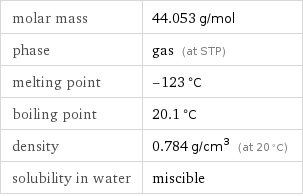
molar mass | 44.053 g/mol phase | gas (at STP) melting point | -123 °C boiling point | 20.1 °C density | 0.784 g/cm^3 (at 20 °C) solubility in water | miscible
Units

Gas properties (at STP)
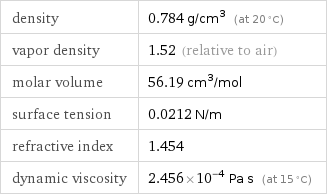
density | 0.784 g/cm^3 (at 20 °C) vapor density | 1.52 (relative to air) molar volume | 56.19 cm^3/mol surface tension | 0.0212 N/m refractive index | 1.454 dynamic viscosity | 2.456×10^-4 Pa s (at 15 °C)
Units

Thermodynamic properties

specific heat capacity c_p | gas | 1.255 J/(g K) molar heat capacity c_p | gas | 55.3 J/(mol K) specific free energy of formation Δ_fG° | gas | -2.928 kJ/g molar free energy of formation Δ_fG° | gas | -129 kJ/mol specific heat of formation Δ_fH° | gas | -3.773 kJ/g molar heat of formation Δ_fH° | gas | -166.2 kJ/mol specific entropy S° | gas | 5.675 J/(g K) molar entropy S° | gas | 250 J/(mol K) molar heat of vaporization | 25.7 kJ/mol | specific heat of vaporization | 0.583 kJ/g | molar heat of combustion | 1169 kJ/mol | specific heat of combustion | 26.54 kJ/g | molar heat of fusion | 2.31 kJ/mol | specific heat of fusion | 0.0524 kJ/g | critical temperature | 466 K | critical pressure | 5.55 MPa | (at STP)
Chemical identifiers
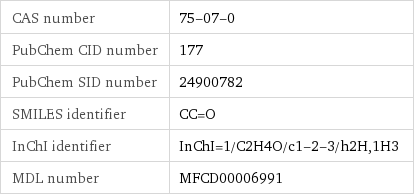
CAS number | 75-07-0 PubChem CID number | 177 PubChem SID number | 24900782 SMILES identifier | CC=O InChI identifier | InChI=1/C2H4O/c1-2-3/h2H, 1H3 MDL number | MFCD00006991
NFPA label

NFPA label
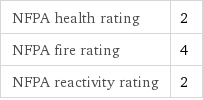
NFPA health rating | 2 NFPA fire rating | 4 NFPA reactivity rating | 2
Safety properties
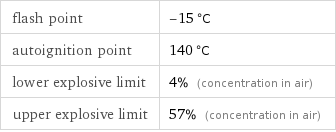
flash point | -15 °C autoignition point | 140 °C lower explosive limit | 4% (concentration in air) upper explosive limit | 57% (concentration in air)

DOT hazard class | 3.1 DOT numbers | 1089
Toxicity properties

lethal dosage | 1930 mg/kg (oral dose for rats) short-term exposure limit | 270 mg/m^3 threshold limit value | 25 ppmv

probable lethal dose for man | 600 mL (milliliters) long-term exposure limit | 180 mg/m^3 (over 8 hours) RTECS classes | tumorigen | mutagen | reproductive effector | human data | primary irritant